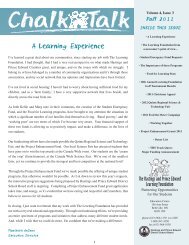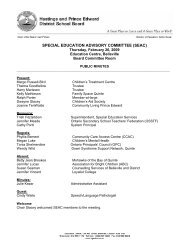Grade 11 Healthy Active Living Education Additional Supports ...
Grade 11 Healthy Active Living Education Additional Supports ...
Grade 11 Healthy Active Living Education Additional Supports ...
Create successful ePaper yourself
Turn your PDF publications into a flip-book with our unique Google optimized e-Paper software.
<strong>Healthy</strong> Relationships and Sexuality<br />
Public Profile<br />
Unit #3 Activity #1<br />
Teaching Learning Strategy #2<br />
Teacher Resource (Information Summary)<br />
Catholic Profile<br />
Unit #4 Activity #1<br />
Teaching Learning Strategy N/A<br />
A. Sexuality<br />
• sexuality and reproductive health are interdependent<br />
• sexuality is a natural and healthy part of living<br />
• sexuality involves more than sex and sex involves more than sexual intercourse<br />
• sexual feelings and sexual behaviour are integral aspects of reproductive health<br />
B. Fertility<br />
Requirements for Male Fertility<br />
• normal sperm production, which includes a healthy ductal system, normal count,<br />
mobility, biological structure and functioning of sperm<br />
• transmit sperm to female vagina through:<br />
− an adequate sexual drive<br />
− the ability to maintain an erection<br />
− the ability to achieve a normal ejaculation<br />
− the placement of ejaculate in vagina<br />
Requirements for Female Fertility<br />
• adequate sexual drive and sexual function to permit coitus<br />
• functioning reproductive anatomy and physiology that include:<br />
− vagina capable of receiving sperm<br />
− normal cervical mucus to allow passage of sperm to the upper genital tract<br />
− ovulatory cycles<br />
− fallopian tubes that will function to permit the sperm and ovum to meet and allow<br />
migration of the product of conception to the uterus<br />
− uterus capable of developing and sustaining the product of conception to maturity<br />
− adequate hormonal status to maintain pregnancy<br />
− normal immunological responses to accommodate sperm, product of<br />
conception (fertilized ovum) and fetal survival<br />
− adequate nutritional, chemical and health status to maintain nutrition and<br />
oxygenation of placenta and fetus<br />
C. Infertility<br />
The most common causes of infertility include:<br />
• the woman not ovulating<br />
• the man not producing a sufficient amount of healthy sperm<br />
• some barrier to the transport of sperm or ovum through the womanÕs fallopian tube<br />
(e.g., scar tissue in the fallopian tubes)<br />
<strong>Grade</strong> <strong>11</strong> <strong>Healthy</strong> <strong>Active</strong> <strong>Living</strong> <strong>Education</strong> (PPL30), Module #1 <strong>Healthy</strong> Relationships and Sexuality<br />
Page 14
















